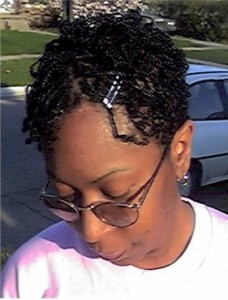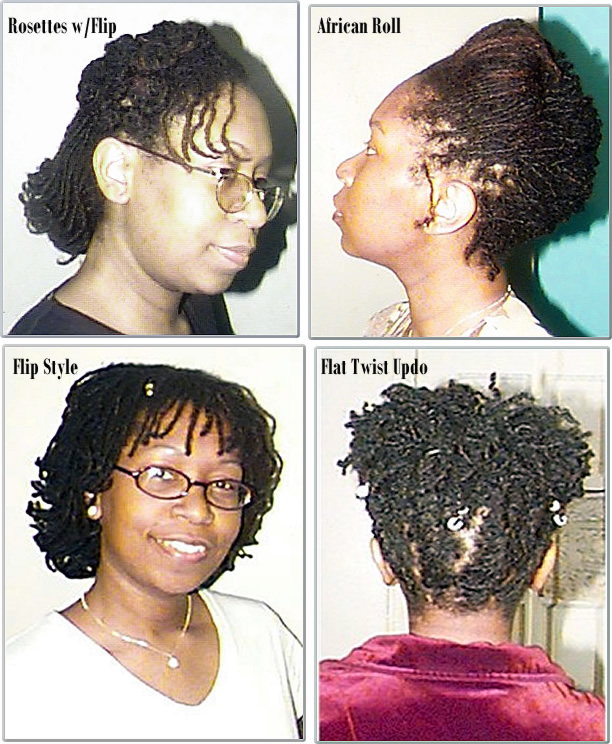Inside: Thick locs , thin locs – does it matter which one you have and is one better than the other? Gain some insight into each to help you decide which is best for you.
When I first embarked upon my Bradelocz journey, I wanted thin locs.
Years later, I ended up combining them to make them thicker. They weren’t super-thick, but definitely bigger than the micro-sized locs I started out with.
And almost 10 years after that, I started a whole new journey of cutting off my first set, and ultimately going back to thinner ones.
My experience with having both thin and (somewhat) thick locs, I feel, allows me to speak about some of the pros and cons of both.
Is There a Particular Size Your Locs SHOULD Be?
This is up for debate, but I’ve always felt that when determining loc size, one of the main factors should be your hair texture and density.
For example: If your hair is very thick and voluminous, thinner locs will create a big, full mane of locs. And don’t get me wrong, there’s definitely nothing wrong with that, in fact; I find it very beautiful.
But some people prefer to NOT have “the big hair look”. Making the loc sections medium-to-big will cut some of that volume.
At the same token; if your hair happens to be more on the thin, fine side… thinner-sized locs may prove the better option for you.
Making them small will create an illusion of more volume and, depending on how you start & maintain them, may be safer, as they will be more lightweight and won’t put too much stress and strain on your roots.

But that’s just my opinion.
As I mentioned before; when I first locked my hair, I wanted thin locs, but over the years, found thicker ones more attractive. Also, I got tired of having to retighten SO many locs, so I made them bigger.
But there were attributes of my thinner locs that I sometimes missed and thus, went back to thin.
So if you’re on the fence about what size to make your locs, check out the following pros and cons of both sizes before you decide.
The Benefits of Thinner Locs
- Fullness: With thin locs, your hair tends to look fuller with more volume, which is a plus for those with thin hair.
- Aesthetics: It’s no secret that there is a certain stigma behind locked hair.
Yes, locs are more widely accepted nowadays, but some people still hold a lot of prejudice towards them. And to those individuals, thin locs help cut down on some of that as they are deemed “more aesthetically pleasing”.
This is NOT to say that we should be trying to please others and base our size on that. But if your job, or what have you, is of concern; tinier locs can be a viable compromise.
- Easily mimics straight styles: One of the reasons people tend to want thinner locs is so they can still wear a lot of the same styles they wore when their hair was straight or just loose.

The Downside of Thin Locs
- Fullness: If your hair is already thick and voluminous, thinner locs could make your hair too big if you don’t particularly care for the “lion’s mane” look.
- Time intensive: Smaller locs take longer to maintain (tightening roots, etc.) which is one of the reasons I decided to combine mine… my arms got tired!
- Maintenance: Separating tiny locs when they try to “marry” together is a lot more tedious.
- Breakage: If you’re not careful and your hair is not at it’s strongest, there can be a greater chance of loc breakage.
- Not as easy to sculpt: There are certain “sculpted” styles that tend to work better with thicker locs. In order to mimic such styles on thinner locs, you’d have to braid/twist them together into thicker sections, then style.
The Benefits of Thick Locs
- Tame that mane: Thicker locs can “tame” super-thick hair if you don’t want a lot of volume.
- Easier to sculpt: Larger locs can more readily be sculpted into certain styles such as: loc fro, pin curls, Bantu-knots, etc.
- Less time intensive: Thick locs usually means LESS locs, which means… less time spent tightening/twisting them.
- Durability: In most cases, they’re stronger and more durable than thinner locs.

The Downside of Thicker Locs
- Less volume: Thicker-sized locs don’t produce as much volume. If your hair is already on the thinner side, this may cause a more “scalpy” appearance. If your hair is thick and you desire to maintain fullness, making your locs thick will minimize your volume.
- May take longer to dry: Larger locs seem to absorb and hold water more & longer.
- Might not mimic loose hair styles in the same way thinner ones do. For some, this is a non-issue, but some strongly desire their locs to mimic loose hair as closely as possible. Thicker locs won’t achieve that as well as skinnier locs.
- Versatility: Depending on how thick they are, they may not be very versatile.
So, Which Size Are YOU Going With?
Hopefully this has helped you come closer to a decision on which size to make your locs.
Just keep in mind things such as: your hair texture and density, how much time you’re willing to spend grooming and maintaining, what kind of styling you’ll want to do, and the overall state of the health of your hair.
But whatever size you choose, your locs will be BEAUTIFUL!
This article was in no way meant to pit one size against another, rather; it’s meant to give you an objective look into the pros and cons of both so you can make an educated decision.
And remember… in the long run, it’s always easier to go from thin to thick, than it is to go from thick to thin!
Blessings & Warmest Regards,